人教新目标版八年级英语下册Unit 2 听说课教学设计(公开课教案)
- 格式:doc
- 大小:29.00 KB
- 文档页数:3
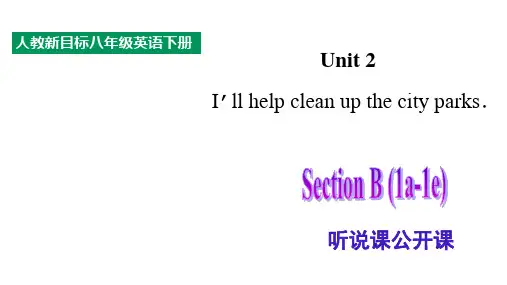
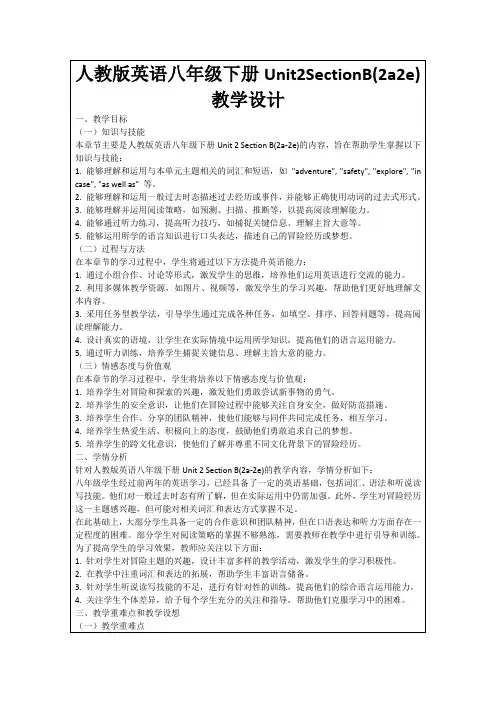
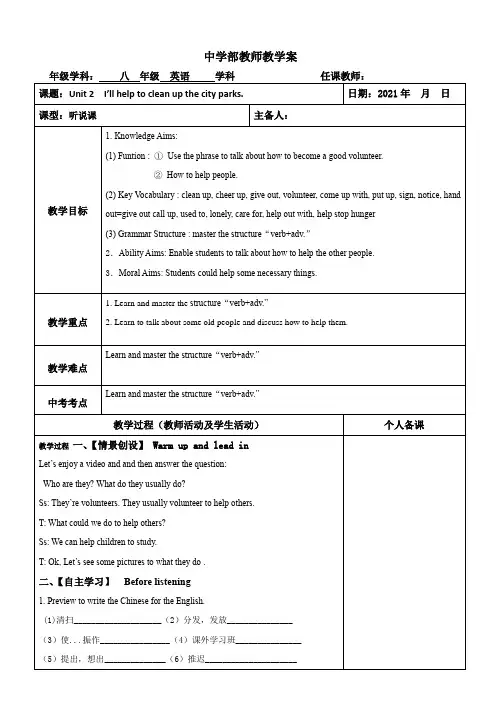
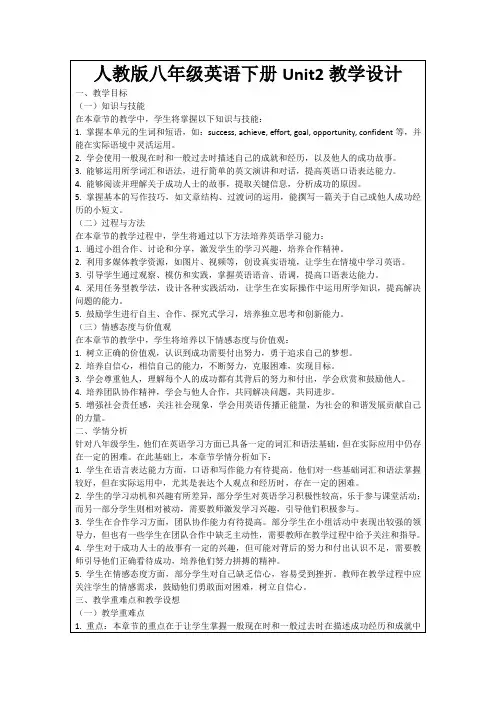

(完整)新人教版英语八年级下unit2教学案(word版可编辑修改)
编辑整理:
尊敬的读者朋友们:
这里是精品文档编辑中心,本文档内容是由我和我的同事精心编辑整理后发布的,发布之前我们对文中内容进行仔细校对,但是难免会有疏漏的地方,但是任然希望((完整)新人教版英语八年级下unit2教学案(word版可编辑修改))的内容能够给您的工作和学习带来便利。
同时也真诚的希望收到您的建议和反馈,这将是我们进步的源泉,前进的动力。
本文可编辑可修改,如果觉得对您有帮助请收藏以便随时查阅,最后祝您生活愉快业绩进步,以下为(完整)新人教版英语八年级下unit2教学案(word版可编辑修改)的全部内容。
Unit 2 Lesson 1 Section A 1a—1c
Unit 2 Lesson 2 Section A 2a-2d
Unit 2 Lesson 3 Section A 3a-3c
Unit 2 Lesson 4 Section A 4a—4c
Unit 2 Lesson5 Section B 1a-1e
Unit 2 Lesson 6 Section B 2a—2e
Unit 2 Lesson 7 Section B 3a-Self Check。
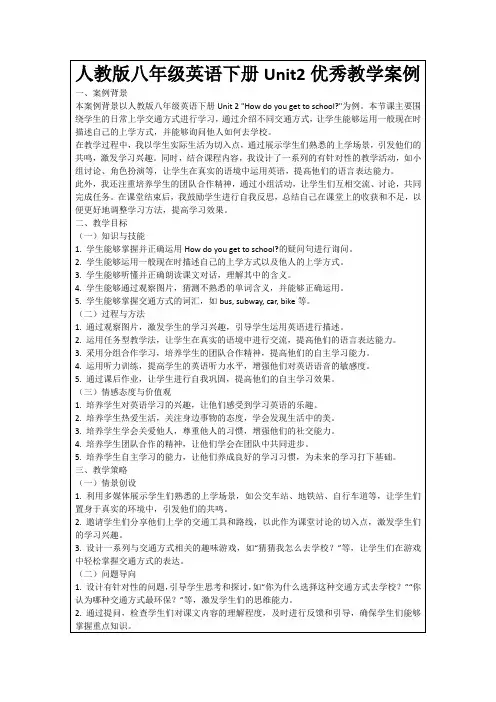
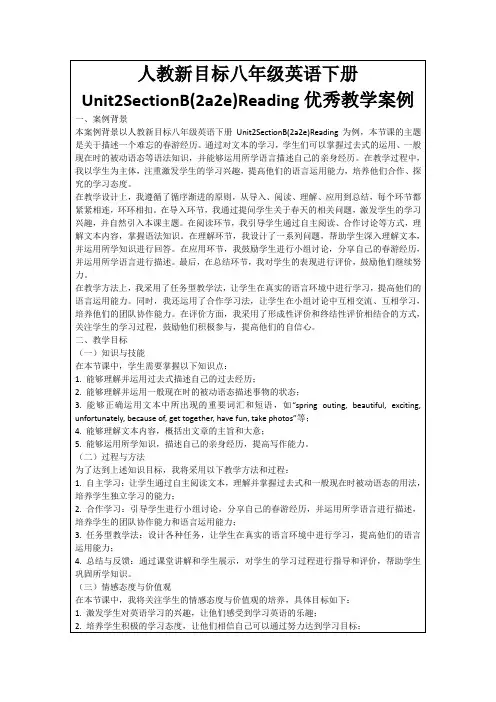
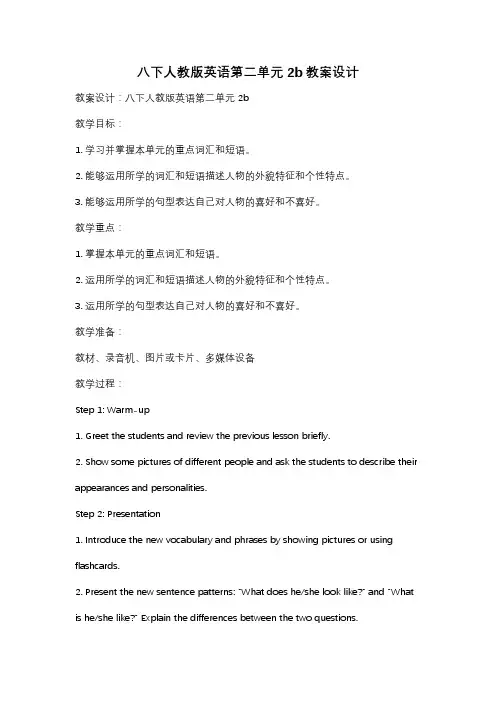
八下人教版英语第二单元2b教案设计教案设计:八下人教版英语第二单元2b教学目标:1. 学习并掌握本单元的重点词汇和短语。
2. 能够运用所学的词汇和短语描述人物的外貌特征和个性特点。
3. 能够运用所学的句型表达自己对人物的喜好和不喜好。
教学重点:1. 掌握本单元的重点词汇和短语。
2. 运用所学的词汇和短语描述人物的外貌特征和个性特点。
3. 运用所学的句型表达自己对人物的喜好和不喜好。
教学准备:教材、录音机、图片或卡片、多媒体设备教学过程:Step 1: Warm-up1. Greet the students and review the previous lesson briefly.2. Show some pictures of different people and ask the students to describe their appearances and personalities.Step 2: Presentation1. Introduce the new vocabulary and phrases by showing pictures or using flashcards.2. Present the new sentence patterns: "What does he/she look like?" and "What is he/she like?" Explain the differences between the two questions.3. Play the recording for the students to listen and repeat the new words, phrases, and sentence patterns.Step 3: Practice1. Divide the class into pairs or small groups.2. Give each group a set of picture cards with different people on them.3. Ask the students to take turns asking and answering questions about the people on the cards using the sentence patterns they have learned. For example: - A: What does he/she look like?- B: He/She has short hair and wears glasses.- A: What is he/she like?- B: He/She is friendly and outgoing.4. Monitor the students' conversations and provide assistance when needed. Step 4: Production1. Ask the students to think about their favorite celebrities or fictional characters.2. In pairs or small groups, have the students describe the appearances and personalities of their chosen characters using the sentence patterns they have learned.3. Encourage the students to use more adjectives and provide reasons for their descriptions.4. Select a few pairs or groups to share their descriptions with the whole class. Step 5: Consolidation1. Review the new vocabulary, phrases, and sentence patterns with the wholeclass.2. Play a game of "Guess Who" where students take turns describing a person and their partner has to guess who they are describing.3. Provide feedback and praise the students' efforts.Step 6: HomeworkAssign homework that reinforces the vocabulary, phrases, and sentence patterns learned in class. For example, students can write a short paragraph describing their favorite celebrity or fictional character.教学延伸:1. 鼓励学生使用更多的形容词和副词来描述人物。
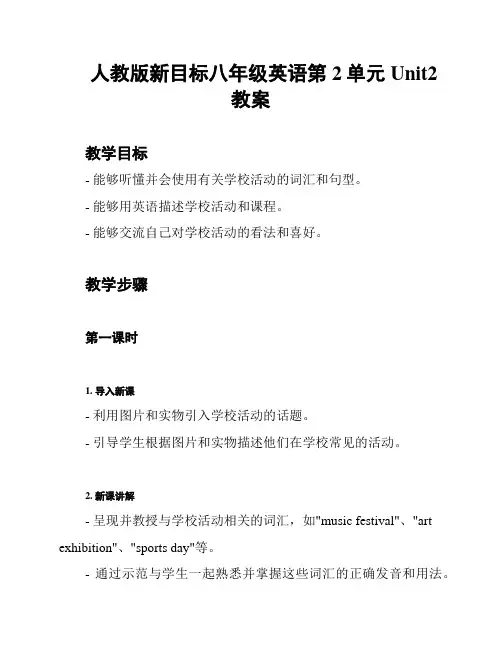
人教版新目标八年级英语第2单元Unit2教案教学目标- 能够听懂并会使用有关学校活动的词汇和句型。
- 能够用英语描述学校活动和课程。
- 能够交流自己对学校活动的看法和喜好。
教学步骤第一课时1. 导入新课- 利用图片和实物引入学校活动的话题。
- 引导学生根据图片和实物描述他们在学校常见的活动。
2. 新课讲解- 呈现并教授与学校活动相关的词汇,如"music festival"、"art exhibition"、"sports day"等。
- 通过示范与学生一起熟悉并掌握这些词汇的正确发音和用法。
- 操练这些词汇,并与学生一起编制句子来描述学校活动。
3. 听力训练- 播放关于学校活动的对话,要求学生仔细听并选择正确的图片。
- 学生互相对话,讨论听到的对话内容。
4. 对话练- 分组或两人一组,让学生模仿对话,表演关于学校活动的场景。
- 鼓励学生用英语进行自由对话,并互相分享自己参与过的学校活动。
5. 作业布置- 课堂分发作业卷,要求学生写一篇短文,介绍自己最喜欢的学校活动,并陈述原因。
第二课时1. 短文分享- 学生轮流与同桌分享自己写的短文。
- 鼓励其他学生提出问题或表达对短文的意见和建议。
2. 阅读训练- 学生阅读一篇关于学校活动的短文,并回答相关问题。
- 教师引导学生理解短文的内容,帮助他们解决阅读中遇到的问题。
3. 语法讲解- 教授句子结构"What do you think of + 学校活动?"和相应的答语。
- 帮助学生理解并掌握这种句子结构的用法。
4. 语法练- 学生分组或两人一组,互相提问"What do you think of + 学校活动?"并回答对方。
- 引导学生用所学词汇和句型互相交流和讨论自己对学校活动的看法和喜好。
5. 总结课堂内容- 教师带领学生回顾本节课所学的词汇、句型和语法。
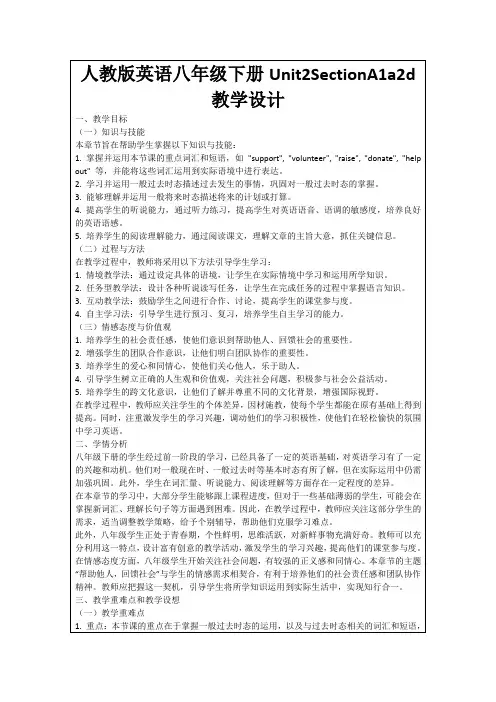

【人教版新目标】英语八年级下册Unit2
单元教案
教学目标
- 通过本单元的研究,学生能够掌握有关时间的表达方式和问时间的方法。
- 学生能够使用现在进行时表达现在正在进行的动作。
- 学生能够运用所学内容进行实际交际。
- 学生能够阅读、理解和撰写与时间有关的文本。
教学准备
- 教材: 《人教版新目标英语八年级下册》
- 多媒体设备
- 黑板、白板或投影屏幕
- 学生练册和作业本
教学过程
导入
1. 利用一些图片、视频或实物引起学生对时间的关注,激发学生的研究兴趣。
规范研究
1. 引导学生研究本单元的词汇和短语,对其进行拼读、理解和运用练。
2. 让学生听录音和跟读对话,掌握现在进行时表达现在正在进行的动作。
拓展研究
1. 带领学生进行交际练,让他们能够用英语问时间和回答时间的问题。
2. 分组进行对话练,加强学生的口语表达能力。
提升研究
1. 给学生分发阅读材料,让他们阅读并回答相关问题,加深对时间概念的理解。
2. 引导学生进行写作练,让他们写一篇短文描述自己一天的日常活动。
教学评估
- 通过学生的课堂表现和活动练,以及书面作业的完成情况来评估学生的掌握程度和进步情况。
教学延伸
- 建议学生在课后进行相关的阅读和听力练,加强对时间的理解和运用能力。
参考资源
- 《人教版新目标英语八年级下册教材》
- 互联网资源(如图片、视频、文章等)。
人教版初中英语八年级下Unit2 讲评课教学设计山东省肥城市陶阳矿学校王海丽教学过程学生课前活动:仔细浏览、分析试卷,进行自查自纠学习活动。
学生课外活动:全面复习本单元相关知识内容。
一. 复习导入(教师活动):There are many volunteer jobs in Unit 2.What are they? What could you do as a volunteer? Maybe the pictures can help you to answer it.出示图片,指明学生回答问题。
We had a test about Unit 2 yesterday. Let’s discuss it together.二. 出示教学目标(教师活动):知识技能:进行有关知识点的复习与整理。
过程与方法:在试卷的讲评过程中,引导学生注重各知识点的归纳总结。
情感态度价值观:通过讲评使学生发现自己的不足并增强学习英语的信心,重点提高写作能力;再次体会投身公益事业是光荣的。
重点:1.本次试题中出错较多的题目;2.各类题型的解题技巧及步骤;3.写作技巧。
难点:写作技巧。
三. 试题分析:本套试题满分100分。
试卷注重知识的考查,突出语言的交际能力,关注学生分析问题、解决问题的能力,既面向全体,又具有一定的难度,试题具有灵活性与综合性,强调运用,贴近生活。
表扬优异及进步的学生:武一帆宋来慧曹沁雪贾一涵孙萌萌陶林帆宋晓轩韩宝龙梁瑞东刘珣珣张鲁意陈淑雅张晨晓郭启振刘明哲学生课堂学习活动:学生自查与自主纠错。
小组长最后统计本组自主纠错出的题目,共计多少分。
注意啦:粗心马虎要不得!四. 互动与交流、小组合作探究:教师课堂活动:在学生进行小组合作期间,及时给予帮助。
学生学习活动:小组合作学习,互帮互助(扮演志愿者:老师)1、针对试卷上自己解决不了的错题,小组内互相交流、讨论,找出致错原因。
2、各组长组织本组同学交流讨论,通过合作学习,解决错题,取得进步。
英语:Unit 2教案(人教新目标八年级下)Teaching aims1. Knowledge aims① Key vocabularies: play CDs, argue with sb, too loud out of style, What’s wrong? surprise, ticket.② Key sentences: What’s the matter with…? / What’s wrong…? /what should I / he / they do? You could / should / … You’d better… Why not…2. Ability aimsTo train students’ ability of judgment.To have Ss give adviceTo improve students’ ability of listening and speaking.3. Emotion aimsTo teach them to understand others.To teach them to help others when they are in trouble.Important difficult pointsTo know about others’ troubleTo use different sentences to give some adviceTeaching aidsTape recorderTeaching StepsBb designWhat’s wrong? / What’s the matter? Play CDS too loudargued with…out of style.What should she/ he / I / they do? She / He / You / should / could do….You’d better…Why not…?Period 2 Section A(3a—4)Teaching aims1. Knowledge aims:a) Key vocabularies: pay for, part-time job, okay, either, bake, Teen Talk, tutor.b) Key sentencesWhat should I do?You could / should/ shouldn’t…He doesn’t have any money, either.2. Ability aims:To train students’ ability of judgment.To improve students’ ability of reading and speaking.3. Emotion aims:To be able to cooperate with others, help each other and complete the task-based activities.Encourage the students to study hard and get over the difficulties.4. Important and difficult points.To give sb. advice.5. Teaching aids: CAITeaching Steps:Bb design: Unit 2 What should I do?Period Twopay for good ideaget a part-time job okay ideahave a bake sale bad ideacall“Teen Talk”get a tutorshy eitherPeriod 3 Section B(1a—2c)Teaching aims:1. Knowledge aimsa) Key vocabularies: Original, in style, haircut, the same as.b) Key sentence:My friend wears the same clothes and has the same haircut as I do.2. Ability aims:Most students would be able to talk about what kind of clothes they like. Improve the ability of finding out main information. Give advice.3. Emotion aims:To be able to cooperate with others, learn how to get on with friends, have their own opinions about fashion.4. Important difficult points:To discuss the topic in a perfect way.5. Teaching aids:Power point and a recorderTeaching Steps:Bb design: Unit 2 What should I do?Period ThreeKim: Tell your friend to get original different clothes and a the same asdifferent haircut. in styleNicole: Be happy that your friend haircutlikes your clothes and haircut.Emilio: Find a new best friend.Period 4 Section B(3a—self-check)Teaching Aims:Knowledge aims:① To master the new words: except, upset, fail.② Continue to learn how to give advice to others.Ability aims:① learn to give others some advice according to their matters.② Students can tell their problems and find some ways to solve their problems. Emotion aims:Learn to be kind to others and give others more cares.Important points:① How to teach the Ss new words.② How to make the Ss help each other when they are in trouble.Difficult points:How to give others some advice according to their matters.Teaching aids: recorder, computer.Teaching design:Blackboard designPeriod 4New words Summaryexcept Talk about problems(诉苦)upsetfail Give advice(提议)Period 5 Maybe you should learn to relax!●Teaching aims and demands:(1) New words and phrases: football, until, fit, as much as possible, pressure, complain, include, pushy, send, all kinds of, compare, crazy, themselves, adult, on the one hand, on the other hand, organized.(2) Key sentences:The tired children don’t get home until 7 p.m.Doctors say many children are under too much pressure.Mothers send their kids to all kinds of classes when they are very young.● Teaching important and difficult points:(1)Students can talk about their problems and find some ways to solve their problems.(2) Understand the meaning of passage.●Ability aims:(1)To improve student’s ability of reading.(2) Students can be a psychologist to solve some problems with a person who is under pressure.●Emotion aims:To be able to cooperate with others and help each other to solve some problems.Don’t complain about others.● Teaching aids:CAI, a tape● Teaching steps:Blackboard designMaybe you should learn to relax!football They didn’t get home until 7:00 p.m.until Teachers complain about teaching tired kids include in the classroom.all kinds of Do your parents compare you with other crazy children?organizedadultcomplain…aboutcompare…withpushyon the one handon the other hand。
Teaching Aims Knowledge Objects1.Master new words and main sentences.2.Read and find out some message.3.Finish exercises through reading.Ability Objects1.Be able to master new words and main sentences.2. Be able to improve students’ ability of reading.3. Be able to Improve ability of reading through reading and doing exercises.Emotion attitudes and valuesTeach students to love others and make them do something to help others.Teaching KeyPoints 1.Master new words and main sentences.2.Improve ability of reading through reading and doing exercises.TeachingDifficult PointsFinish exercises through reading.TeachingMethodsReadingLearningMethodsReadingTeachingpreparationRadioTeaching Procedures Teaching Notes Step I Warming up and revisionStep II ReadingFast Reading1. T: Now let’s work on 2b. First, let’s read the questions and make surewe know the meanings of all the questions. Then read the passagequickly and find the answers to the questions.1) What kind of letter is it? 2) Who wrote the letter to Miss Li? Why?2. Ss read the letter quickly and try to find the answers to the twoquestions.3. Check the answers with the class.Careful Reading1. T: Now let’s read these sentences about the letter. Read the passageagain. Judge if the sentences are True or False. Please underline underthe main sentences.1) The writer can’t use her arms or legs w ell.2) Lucky was brought to the writer by her friend.3) They have been trained at “Animal helpers” for seven months.4) A dog-helper is for those who are disabled.5) Lucky can understand different orders.Language points1) I’m sure you know that this group was set up to help disabled peoplelike me. set up e.g. Let’s set up our tent by the river.2) Lucky makes a big difference to my life.make a diff erence e.g. It would make a big difference to my life.3) I love animals and I was excited about the idea of having a dog.excited adj. 激动的;兴奋的4) …but many people have these difficulties.difficulty n. 困难;难题difficult adj. 困难的difficulty n.e.g. When you’re in difficulty, ask me for difficulty.Work on 2c1. Let some Ss circle the part of speech.2. Ss try to make sentences with the words.3. Let some Ss read their sentences and correct their mistakes.4. Ss check the sentences with their partners.Work on 2d1.Ss work by themselves.2. Check the answers together.Step III Discussing1. Ss talk about with partners.2. Ask some Ss say what their answers.Step IV Homework :1. Learn some words by heart.2. Finish off some WB. Exercises.3. Try to retell the letter.Reflection afterteaching单元(章) 名称、课题Unit 2 I’ll help to clean up the city parks.Section B 2 (3a-Self check)课时划分8课时教学课时第8课时总备课数第16课时。
Unit 2 I’ll help to clean up the city parks.
听说课教学设计
Teaching aims:
Knowledge aims:
Students can master some useful ways to help others and use them to offer help.
Ability aims:
Students can use some useful expressions about offering help to help people in need.
Students will learn some useful listening skills to get specific information from the listening material.
Emotional aims:
Students would like to help others in need by using useful ways in daily life. .
Students will like to cooperate with their classmates to do English activities in class.
Teaching key points and difficult points:
Key points:
Students can know some expressions about useful ways to express their ideas .
Students can can use some useful ways to help people in need.
Difficult Points:
Students would like to help others in need by using useful ways in daily life.
Teaching procedures:
Step 1 Lead-in
Greet students and show some pictures about volunteering activities then
ask students to guess what they are doing. In this way, the teacher will lead the topic of “offering help”.
(Justification: The teacher can lead the topic of “offering help very naturally and it can also arouse students’ interest and enlighten their mind.) Step 2 Pre-listening
Ask students to have a free talk about whether they have worked as a volunteers, what kind of volunteering activity they did. Then teachers guide students to look at the pictures of 1a and list more ways to help others.
(Justification: students can recall their experiences about offering help, it can also attract students’ attention and make a good preparation for the following learning.)
Step 3 While-listening
1.extensive listening
Listen to the radio of 1b for the first time and answer the following questions:
(1) How many speakers are their in this dialogue?
(2) what are they talking about?
(Justification: Students’ extensive listening skills can be trained. Students can get the main idea of the dialogue through grasping some key words.)
2.intensive listening
1).Listen to the radio of 1b for the second time and number the ways the boy and the girl could help others.
2).Listen to the radio of 1b for the third time, show the listening material on the PPT and ask students to read after it.
(Justification: These tasks can help students understand this dialogue much better. This activity can also develop students’ listening skills about getting detailed information and prepare well for their following speaking.) Step 4 Post-listening
Group work: Ask students to read the conversation in 1b and find out useful
sentence patterns and then make their own conversations.
Role play: Invite some pairs to show their conversations in the front of the classroom.
(Justification: This group work can achieve the emotional aims to increase their interest in cooperating with others and they can practice what they have learned in class. Also, speaking in the front of the classroom can cultivate students courage of speaking English.)
Step 5 Summary and homework
Summary: The teacher guides students to summarize what we have learned today together.
Homework: Ask students to write more ways of offering help and practice the conversation we’ve learned in this class.
Blackboard design:
Unit 2 I’ll help to clean up the city parks
Help to clean up the city
Visit sick kids in the hospital to cheer them up
Ways to help others Give out food in food bank
Could volunteer in an after school program to teach kids。